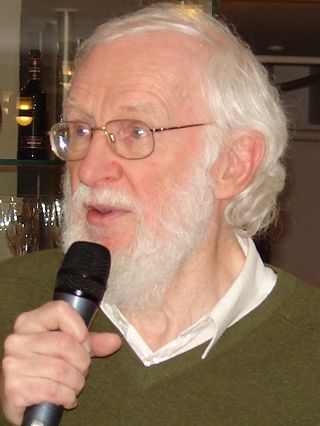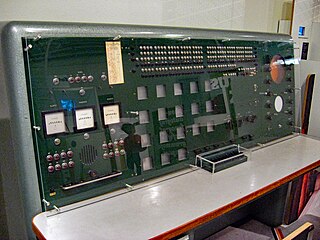
In computer science, a microkernel is the near-minimum amount of software that can provide the mechanisms needed to implement an operating system (OS). These mechanisms include low-level address space management, thread management, and inter-process communication (IPC).
In distributed computing, a remote procedure call (RPC) is when a computer program causes a procedure (subroutine) to execute in a different address space, which is written as if it were a normal (local) procedure call, without the programmer explicitly writing the details for the remote interaction. That is, the programmer writes essentially the same code whether the subroutine is local to the executing program, or remote. This is a form of client–server interaction, typically implemented via a request–response message passing system. In the object-oriented programming paradigm, RPCs are represented by remote method invocation (RMI). The RPC model implies a level of location transparency, namely that calling procedures are largely the same whether they are local or remote, but usually, they are not identical, so local calls can be distinguished from remote calls. Remote calls are usually orders of magnitude slower and less reliable than local calls, so distinguishing them is important.

Peter Naur was a Danish computer science pioneer and 2005 Turing award winner. He is best remembered as a contributor, with John Backus, to the Backus–Naur form (BNF) notation used in describing the syntax for most programming languages. He also contributed to creating the language ALGOL 60.

BESK was Sweden's first electronic computer, using vacuum tubes instead of relays. It was developed by Matematikmaskinnämnden and for a short time it was the fastest computer in the world. The computer was completed in 1953 and in use until 1966. The technology behind BESK was later continued with the transistorized FACIT EDB and FACIT EDB-3 machines, both software compatible with BESK. Non-compatible machines highly inspired by BESK were SMIL made for the University of Lund, SAABs räkneautomat SARA, "SAAB's calculating machine", and DASK made in Denmark.

Per Brinch Hansen was a Danish-American computer scientist known for his work in operating systems, concurrent programming and parallel and distributed computing.
KDF9 was an early British 48-bit computer designed and built by English Electric. The first machine came into service in 1964 and the last of 29 machines was decommissioned in 1980 at the National Physical Laboratory. The KDF9 was designed for, and used almost entirely in, the mathematical and scientific processing fields – in 1967, nine were in use in UK universities and technical colleges. The KDF8, developed in parallel, was aimed at commercial processing workloads.

The Bendix G-15 is a computer introduced in 1956 by the Bendix Corporation, Computer Division, Los Angeles, California. It is about 5 by 3 by 3 feet and weighs about 966 pounds (438 kg). The G-15 has a drum memory of 2,160 29-bit words, along with 20 words used for special purposes and rapid-access storage. The base system, without peripherals, cost $49,500. A working model cost around $60,000. It could also be rented for $1,485 per month. It was meant for scientific and industrial markets. The series was gradually discontinued when Control Data Corporation took over the Bendix computer division in 1963.
The THE multiprogramming system or THE OS was a computer operating system designed by a team led by Edsger W. Dijkstra, described in monographs in 1965-66 and published in 1968. Dijkstra never named the system; "THE" is simply the abbreviation of "Technische Hogeschool Eindhoven", then the name of the Eindhoven University of Technology of the Netherlands. The THE system was primarily a batch system that supported multitasking; it was not designed as a multi-user operating system. It was much like the SDS 940, but "the set of processes in the THE system was static".

The LGP-30, standing for Librascope General Purpose and then Librascope General Precision, is an early off-the-shelf computer. It was manufactured by the Librascope company of Glendale, California, and sold and serviced by the Royal Precision Electronic Computer Company, a joint venture with the Royal McBee division of the Royal Typewriter Company. The LGP-30 was first manufactured in 1956, at a retail price of $47,000, equivalent to $530,000 in 2023.
The RC 4000 Multiprogramming System is a discontinued operating system developed for the RC-4000 minicomputer in 1969. For clarity, this article mostly uses the term Monitor.
The ICT 1301 and its smaller derivative ICT 1300 were early business computers from International Computers and Tabulators. Typical of mid-sized machines of the era, they used core memory, drum storage and punched cards, but they were unusual in that they were based on decimal logic instead of binary.

The DASK was the first computer in Denmark. It was commissioned in 1955, designed and constructed by Regnecentralen, and began operation in September 1957. DASK is an acronym for Dansk Aritmetisk Sekvens Kalkulator or Danish Arithmetic Sequence Calculator. Regnecentralen almost did not allow the name, as the word dask means "slap" in Danish. In the end, however, it was named so as it fit the pattern of the name BESK, the Swedish computer which provided the initial architecture for DASK.
The separation of mechanism and policy is a design principle in computer science. It states that mechanisms should not dictate the policies according to which decisions are made about which operations to authorize, and which resources to allocate.
Jørn Jensen was one of the earliest Danish computer programmers. Examined as a mechanical engineer, he had worked with electromechanical construction. In 1958, he was employed at the Danish Regnecentralen (RC), and very soon exhibited an extraordinary programming skill. He developed the main parts of the base programs to the Dansk Aritmetisk Sekvens Kalkulator, the first Danish computer. Among other programs, he designed a set of monitor programs to supervise the program running schedule on DASK. In tight collaboration with Peter Naur and others, he developed reliable, well documented compilers for the ALGOL 60 programming language. In this context, he invented Jensen's Device, an ingenious exploitation of the name parameters to compute numerical series without using procedure parameters, as is needed in all programming languages, except ALGOL 60 and Simula 67.

The English Electric System 4 was a mainframe computer announced in 1965. It was derived from the RCA Spectra 70 range, itself a variant of the IBM System 360 architecture.

The kernel is a computer program at the core of a computer's operating system and generally has complete control over everything in the system. The kernel is also responsible for preventing and mitigating conflicts between different processes. It is the portion of the operating system code that is always resident in memory and facilitates interactions between hardware and software components. A full kernel controls all hardware resources via device drivers, arbitrates conflicts between processes concerning such resources, and optimizes the utilization of common resources e.g. CPU & cache usage, file systems, and network sockets. On most systems, the kernel is one of the first programs loaded on startup. It handles the rest of the startup as well as memory, peripherals, and input/output (I/O) requests from software, translating them into data-processing instructions for the central processing unit.
ICT 1900 was a family of mainframe computers released by International Computers and Tabulators (ICT) and later International Computers Limited (ICL) during the 1960s and 1970s. The 1900 series was notable for being one of the few non-American competitors to the IBM System/360, enjoying significant success in the European and British Commonwealth markets.










